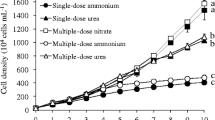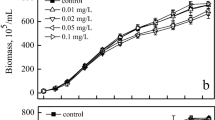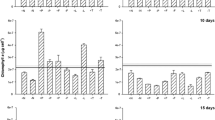Abstract
ANT is a commonly occurring polycyclic aromatic hydrocarbon (PAH) in natural eutrophic waters where Microcystis blooms break out usually. In this study, effects of ANT at different concentrations (0.02, 0.06, 0.18, 0.54, and 1.62 μg/mL) on the growth, microcystin-LR (MC-LR) production, and expression of three key mcy genes in Microcystis aeruginosa were investigated. The results showed that all the tested concentrations of ANT inhibited M. aeruginosa growth significantly except 0.02 μg/mL ANT in the early stage of the experiment. In the culture media, initially applied ANT concentrations decreased significantly after 3 days of incubation. ANT stimulated MC-LR production in a concentration-dependent manner. After exposure to ANT for 1 day, the expression of mcyB gene was inhibited and the inhibitory effects increased with ANT concentrations. ANT at higher concentrations (above 0.02 μg/mL) stimulated gene expression of mcyD (P < 0.05) and mcyH (P < 0.01) significantly, and 0.02 μg/mL of ANT inhibited their expression significantly (P < 0.01). With increasing culture time, 0.18 μg/mL of ANT inhibited mcyB gene expression first and then stimulated it while gene expressions of mcyD and mcyH were stimulated throughout the experiment. Our results suggested that ANT in natural waters could affect not only Microcystis growth but also MC production via modifying mcy gene expressions.






Similar content being viewed by others
References
Calabrese, E. J. (2005). Paradigm lost, paradigm found: the reemergence of hormesis as a fundamental dose response model in the toxicological sciences. Environ Pollut, 138(3), 378–411.
Chen, X. G., Xiang, H. Y., Hu, Y., Zhang, Y., Yang, L. O., & Gao, M. Y. (2014). Fates of Microcystis aeruginosa cells and associated microcystins in sediment and the effect of coagulation process on them. Toxins, 6(1), 152–167.
DeMott, W. R. (1999). Foraging strategies and growth inhibition in five daphnids feeding on mixtures of toxic cyanobacterium and a green alga. Freshw Biol, 42, 263–274.
Dittmann, E., & Wiegand, C. (2006). Cyanobacterial toxins-occurrence, biosynthesis and impact on human affairs. Mol Nutr Food Res, 50(1), 7–17.
Dong, C. D., Chen, C. F., & Chen, C. W. (2012). Determination of polycyclic aromatic hydrocarbons in industrial harbor sediments by GC-MS. Int J Environ Res Public Health, 9(6), 2175–2188.
Downing, T. G., Sember, C. S., Gehringer, M. M., & Leukes, W. (2005). Medium N:P ratios and specific growth rate comodulate microcystin and protein content in Microcystis aeruginosa PCC7806 and M. aeruginosa UV027. Microb Ecol, 49(3), 468–473.
Fiore, M. F., Genuario, D. B., da Silva, C. S. P., Shishido, T. K., Moraes, L. A. B., Cantusio Neto, R., et al. (2009). Microcystin production by a freshwater spring cyanobacterium of the genus Fischerella. Toxicon, 53, 754–761.
Gan, N. Q., Xiao, Y., Zhu, L., Wu, Z. X., Liu, J., Hu, C. L., et al. (2012). The role of microcystins in maintaining colonies of bloom-forming Microcystis spp. Environ Microbiol, 14(3), 730–742.
Gouvea, S. P., Boyer, G. L., & Twiss, M. R. (2008). Influence of ultraviolet radiation, copper, and zinc on microcystin content in Microcystis aeruginosa (Cyanobacteria). Harmful Algae, 7(2), 194–205.
Guo, G. H., Wu, F. C., He, H. P., Zhang, R. Q., & Li, H. X. (2012). Spatial distribution of ecological risk of polycyclic aromatic hydrocarbons in the surface waters of Lake Taihu (in Chinese). Zhong Guo Huan Jing Ke Xue, 32(6), 1032–1039.
Guo, W., Pei, Y. S., Yang, Z. F., & Chen, H. (2011). Historical changes in polycyclic aromatic hydrocarbons (PAHs) input in Lake Baiyangdian related to regional socio-economic development. J Hazard Mater, 187(1-3), 441–449.
Harada, K. I., Tsuji, K., Watanabe, M. F., & Kondo, F. (1996). Stability of microcystins from cyanobacteria-III. Effect of pH and temperature. Phycologia, 35, 83–88.
He, E. Q., Niu, W. M., Wu, Q. G., Zhou, W. J., Yan, L., Zhang, Y. Z., et al. (2011). Establishment of taqMan real-time fluorescence PCR of gene McyA of toxin-producing Microcystis spp (in Chinese). Huan Jing Ke Xue Yu Ji Shu, 34(12), 66–70.
Hoeger, S. J., Schmid, D., Blom, J. F., Ernst, B., & Dietrich, D. R. (2007). Analytical and functional characterization of microcystins [Asp3] MC-RR and [Asp3, Dhb7] MC-RR: consequences for risk assessment. Environ Sci Technol, 41(7), 2609–2616.
Hong, Y. W., Yuan, D. X., Lin, Q. M., & Yang, T. L. (2008). Accumulation and biodegradation of phenanthrene and fluoranthene by the algae enriched from a mangrove aquatic ecosystem. Mar Pollut Bull, 56(8), 1400–1405.
Iredale, R. S., McDonald, A. T., & Adams, D. G. (2012). A series of experiments aimed at clarifying the mode of action of barley straw in cyanobacterial growth control. Water Res, 46(18), 6095–6103.
Kaebernick, M., Neilan, B. A., Börner, T., & Dittmann, E. (2000). Light and the transcriptional response of the microcystin biosynthesis gene cluster. Appl Environ Microbiol, 66(8), 3387–3392.
Kafilzadeh, F. (2015). Distribution and sources of polycyclic aromatic hydrocarbons in water and sediments of the Soltan Abad River, Iran. The Egyptian Journal of Aquatic Research, 41(3), 227–231.
Li, J. W., Shang, X., Zhao, Z. X., Tanguay, R. L., Dong, Q. X., & Huang, C. J. (2010). Polycyclic aromatic hydrocarbons in water, sediment, soil, and plants of the Aojiang River waterway in Wenzhou, China. J Hazard Mater, 173, 75–81.
Livak, K. J., & Schmittgen, T. D. (2001). Analysis of relative gene expression data using real-time quantitative PCR and the 2-△△CT method. Methods, 25, 402–408.
Long, B. M., Jones, G. J., & Orr, P. T. (2001). Cellular microcystin content in N-limited Microcystis aeruginosa can be predicted from growth rate. Appl Environ Microbiol, 67(1), 278–283.
Mohamed, Z. A., & Al-Shehri, A. M. (2013). Grazing on Microcystis aeruginosa and degradation of microcystins by the heterotrophic flagellate Diphylleia rotans. Ecotoxicol Environ Saf, 96, 48–52.
Nikolaou, A. D., Kostopoulou, M., Lofrano, G., & Meric, S. (2009). Determination of PAHs in marine sediments: analytical methods and environmental concerns. Global NEST Journal, 11(4), 391–405.
Matsushima-Nishiwaki, R., Ohta, T., Nishiwaki, S., Suganuma, M., Kohyama, K., Ishiwaka, T., et al. (1992). Liver tumor promotion by the cyanobacterial cyclic peptide toxin microcystin-LR. J Cancer Res Clin Oncol, 118(6), 420–424.
Noguchi, T., Shinohara, A., & Nishizawa, A. (2009). Genetic analysis of the microcystin biosynthesis gene cluster in Microcystis strains from four bodies of eutrophic water in Japan. J Gen Appl Microbiol, 55(2), 111–123.
Pan, X. J., Chang, F. Y., Kang, L. J., Liu, Y. D., Li, G. B., & Li, D. H. (2008). Effects of gibberellin A3 on growth and microcystin production in Microcystis aeruginosa (Cyanophyta). J Plant Physiol, 165(16), 1691–1697.
Pearson, L. A., Hisbergues, M., Börner, B., Dittmann, E., & Neilan, B. A. (2004). Inactivation of an ABC transporter gene, mcyH, results in loss of microcystin production in the cyanobacterium Microcystis aeruginosa PCC 7806. Appl Environ Microbiol, 70(11), 6370–6378.
Rantala, A., Fewer, D. P., Hisbergues, M., Rouhiainen, L., Vaitomaa, J., Börner, T., et al. (2004). Phylogenetic evidence for the early evolution of microcystin synthesis. Proc Natl Acad Sci U S A, 101(2), 568–573.
Renaud, S. L., Pick, F. R., & Fortin, N. (2011). Effect of light intensity on the relative dominance of toxigenic and nontoxigenic strains of Microcystis aeruginosa. Appl Environ Microbiol, 77(19), 7016–7022.
Song, R. F., Wang, G. X., Xu, Y., Shao, J. H., Wang, Z. J., Liu, Y., et al. (2011). Transcriptional response of microcystin biosynthesis gene cluster of Microcystis aeruginosa PCC7806 under Daphnia stress using real-tmie RT-PCR technique (in Chinese). Hu Po Ke Xue, 23(1), 150–154.
Tanabe, Y., Sano, T., Kasai, F., & Watanabe, M. M. (2009). Recombination, cryptic clades and neutral molecular divergence of the microcystin synthetase (mcy) genes of toxic cyanobacterium Microcystis aeruginosa. BMC Evol Biol, 9, 115.
Tillett, D., Dittmann, E., Erhard, M., von Döhren, H., Börner, T., & Neilan, B. A. (2000). Structural organization of microcystin biosynthesis in Microcystis aeruginosa PCC7806: an integrated peptide-polyketide synthetase system. Chem Biol, 7(10), 753–764.
Westhuizen, A. J., & Eloff, J. N. (1985). Effect of temperature and light on the toxicity and growth of the blue-green alga Microcystis aeruginosa (UV-006). Planta, 163(1), 55–59.
Wiedner, C., Visser, P. M., Fastner, J., Metcalf, J. S., Codd, G. A., & Mur, L. R. (2003). Effects of light on the microcystin content of Microcystis strain PCC 7806. Appl Environ Microbiol, 69(3), 1475–1481.
Wong, P. K. (2000). Effects of 2, 4 - D, glyphosate and paraquat on growth, photosynthesis and chlorophyll-a synthesis of Scenedesmus quadricauda Berb 614. Chemosphere, 41, 177–182.
Wu, Z. X., Gan, N. Q., Huang, Q., & Song, L. R. (2007). Response of Microcystis to copper stress - do phenotypes of Microcystis make a difference in stress tolerance? Environ Pollut, 147(2), 324–330.
Xu, Q. J., Chen, W. M., & Gao, G. (2008). Seasonal variations in microcystin concentrations in Lake Taihu, China. Environ Monit Assess, 145(1-3), 75–79.
Zhang, C., Yi, Y. L., Hao, K., Liu, G. L., & Wang, G. X. (2013). Algicidal activity of Salvia miltiorrhiza bung on Microcystis aeruginosa—towards identification of algicidal substance and determination of inhibition mechanism. Chemosphere, 93, 997–1004.
Zhu, X. Z., Kong, H. L., Gao, Y. Z., Wu, M. F., & Kong, F. X. (2012). Low concentrations of polycyclic aromatic hydrocarbons promote the growth of Microcystis aeruginosa. J Hazard Mater, 237–238, 371–375.
Acknowledgments
The financial supports provided by the National Natural Science Foundation of China (Grant No. 31300393), China Postdoctoral Science Foundation (Grant No. 2015T80212, 2014M551013), Project of Tianjin Municipal Science and Technology (Grant No. 16JCYBJC29900, 15ZCZDNC00230), and Modern Aqua-ecology and Health Aquaculture Innovation Team of Tianjin (Grant No. TD12-5018) are gratefully acknowledged.
Author information
Authors and Affiliations
Corresponding author
Rights and permissions
About this article
Cite this article
Bi, X., Dai, W., Zhou, Q. et al. Effect of Anthracene (ANT) on Growth, Microcystin (MC) Production and Expression of MC Synthetase (mcy) Genes in Microcystis aeruginosa . Water Air Soil Pollut 227, 259 (2016). https://doi.org/10.1007/s11270-016-2956-2
Received:
Accepted:
Published:
DOI: https://doi.org/10.1007/s11270-016-2956-2




